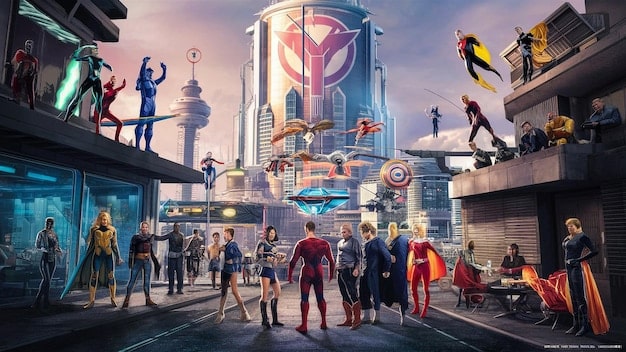Superhero Movie Box Office: 2015-2025 Evolution & Revenue

The landscape of superhero movies has undergone a significant transformation between 2015 and 2025, marked by shifting box office revenues influenced by evolving cinematic universes, audience fatigue, streaming service impacts, and the rise of diverse storytelling approaches that redefine profitability and cultural resonance within the global entertainment industry.
The superhero genre has long captivated audiences worldwide, evolving from niche comic book adaptations into a dominant force in cinematic entertainment. Understanding The Evolution of Superhero Movies: Comparing Box Office Revenue from 2015 to 2025 offers a fascinating look at how this genre has adapted to changing viewer habits, technological advancements, and a competitive media landscape. From the peak of interconnected universes to the rise of independent ventures and the impact of streaming, the last decade has been a rollercoaster for these caped crusaders and their financial triumphs, or sometimes, their unexpected challenges.
The golden age and its initial tremors (2015-2018)
Between 2015 and 2018, superhero movies were arguably at their zenith, particularly fueled by the seemingly unstoppable momentum of the Marvel Cinematic Universe (MCU). This period saw a consistent stream of highly anticipated releases, many of which shattered box office records and redefined what was possible for shared cinematic universes. Audiences flocked to theaters, eager to witness the culmination of interconnected storylines and character arcs meticulously crafted over years.
The success was not just about individual films but the overarching narrative provided by studios like Disney (via Marvel) and Warner Bros. (with DC). These studios leveraged massive marketing campaigns, star power, and a deep understanding of fan expectations to create cultural phenomena. The novelty of seeing beloved characters interact and storylines intertwine across multiple films kept audiences invested, contributing significantly to robust box office figures globally. This era cemented superhero films as tentpole releases, critical for studio profitability.
Marvel’s continued dominance
Marvel Studios, under Kevin Feige, perfected the formula during this period. Releases like “Avengers: Age of Ultron” (2015), “Captain America: Civil War” (2016), “Black Panther” (2018), and “Avengers: Infinity War” (2018) were not just blockbusters; they were cultural events. “Black Panther,” in particular, demonstrated the genre’s ability to transcend traditional demographics, becoming a global phenomenon and a critical darling, exceeding all box office expectations.
- Consistent quality and critical acclaim for most MCU entries.
- Ability to build anticipation through interconnected narratives.
- Expansion into diverse character representations and storytelling.
- Strong post-credit scenes creating buzz for future films.
DC’s challenging but improving landscape
While Marvel soared, DC’s cinematic universe (DCEU) faced a rockier path during these years. Films like “Batman v Superman: Dawn of Justice” (2016) and “Justice League” (2017) garnered mixed to negative critical reception, often falling short of box office expectations relative to their budgets. However, glimmers of hope emerged with “Wonder Woman” (2017), which was widely praised and performed strongly, proving the potential for DC properties with the right creative vision.
The struggles highlighted the difficulty in replicating Marvel’s long-term planning and cohesive universe-building. Warner Bros. experimented with different tones and directorial visions, leading to a sometimes disjointed cinematic experience for viewers. Despite these challenges, the immense cultural weight of characters like Batman and Superman ensured a baseline level of interest and box office performance, even if not reaching their full potential.

Navigating the apex and the shift (2019-2021)
The years 2019 to 2021 proved to be a pivotal period for superhero films, marked by both a monumental peak and unprecedented challenges. 2019 saw the cinematic universe concept reach its commercial and narrative climax, only for the world to be plunged into a global pandemic that drastically reshaped the entire film industry, including the release strategies and profitability models for blockbusters.
The shift was dramatic, moving from a trajectory of ever-increasing theatrical revenue to forced innovation in distribution, primarily through streaming platforms. This era tested the resilience of the superhero genre, forcing studios to adapt quickly while navigating global lockdowns, cinema closures, and evolving audience comfort levels with public gatherings.
The peak moment: “Avengers: Endgame”
2019 was undoubtedly dominated by “Avengers: Endgame,” which became the highest-grossing film of all time globally (surpassing “Avatar”) upon its initial release, demonstrating the extraordinary power of a decade of interconnected storytelling. This film was the ultimate culmination of the MCU’s Infinity Saga, drawing in casual viewers and hardcore fans alike, establishing unparalleled anticipation and record-breaking opening weekends. Its success validated the long-form storytelling approach and the immersive world-building characteristic of the MCU.
- Record-breaking box office figures, proving the immense demand.
- Culmination of a decade of narrative building.
- High critical and audience acclaim, fostering repeat viewings.
- Cultural phenomenon status, transcending typical film viewership.
This period also saw other strong performers like “Spider-Man: Far From Home” (2019) maintaining Marvel’s momentum, and “Joker” (2019), a standalone DC film, which proved that dark, character-driven narratives outside of a shared universe could also achieve massive critical and commercial success, even breaking the billion-dollar mark with an R-rating.
The pandemic’s profound impact
The COVID-19 pandemic, starting in early 2020, brought the global film industry to a standstill. Production delays, cinema closures, and audience hesitancy led to a dramatic decline in theatrical revenue. Superhero films, heavily reliant on a theatrical release model for their financial success, were particularly affected. Many high-profile releases were delayed repeatedly, or their distribution strategies were fundamentally altered.
Studios began experimenting with hybrid release models, simultaneously releasing films in theaters and on streaming services (e.g., Disney+ Premier Access for “Black Widow,” HBO Max for “Wonder Woman 1984”). While these strategies provided content to audiences during lockdowns and boosted streaming subscriptions, they often led to significantly lower theatrical box office numbers, complicating the economics for tentpole productions. This era highlighted the vulnerability of the traditional theatrical window and accelerated the industry’s pivot towards a more diversified distribution strategy.
The streaming push and audience recalibration (2022-2023)
The years 2022 and 2023 represented a complex period for superhero movies, as the industry grappled with the lingering effects of the pandemic and the accelerated shift towards streaming. While theatrical releases slowly began to stabilize, audience habits had recalibrated, often preferring the convenience of at-home viewing. This era challenged the traditional box office success metrics for superhero films, leading to varied results.
Studios continued to experiment with release windows and exclusivity, balancing the desire for theatrical revenue with the need to feed their burgeoning streaming platforms. The sheer volume of superhero content, both films and TV series, also began to raise questions about potential audience fatigue and the sustainability of the genre’s dominance.
Mixed theatrical results and fatigue concerns
While some superhero films managed to deliver strong box office performances, such as “Spider-Man: No Way Home” (released late 2021 but its impact extended into 2022) which defied pandemic expectations, others struggled to reach pre-pandemic levels of revenue. Films that might have been guaranteed hits in previous years found themselves underperforming, signaling a shift in audience selectivity. Factors contributing to this included:
- Increased domestic and international competition from other genres.
- Evolving critical reception, with some films facing harsher reviews.
- Perceived quality issues or lack of clear narrative direction in some franchises.
- The “wait for streaming” mentality becoming more prevalent among viewers.
This period saw a greater divergence in performance, with certain films breaking through while others faced significant challenges, prompting studios to re-evaluate their strategies. The sheer number of releases also led to discussions within the industry and among fans about “superhero fatigue,” suggesting that the market was becoming saturated.
The rise of companion series and cross-platform strategies
To further bolster their streaming services, studios heavily invested in developing companion TV series set within their cinematic universes. Disney+ became a key platform for the MCU with shows like “Loki” and “WandaVision,” while HBO Max continued to host DC content. These series were designed to deepen character development, expand narratives, and keep audiences engaged between major film releases, thereby creating a symbiotic relationship between theatrical and streaming content.
This cross-platform strategy aimed to monetize the intellectual property more effectively across different revenue streams. While a boon for streaming subscribers, it also meant that the ecosystem of superhero content became more diffuse, perhaps diluting the singular focus on theatrical box office as the sole measure of success. The financial model became more complex, incorporating subscriber growth and engagement metrics alongside traditional ticket sales.

Future outlook (2024-2025): Reinvention and re-evaluation
Looking ahead to 2024 and 2025, the superhero movie landscape is poised for significant reinvention and re-evaluation. Having navigated the peaks and troughs of the past decade, studios are now actively adapting to a more discerning audience, a competitive streaming environment, and the need for fresh narrative approaches. The era of guaranteed blockbusters simply by virtue of being a superhero film may be behind us, replaced by a demand for quality, originality, and clear storytelling.
This period is expected to be defined by a strategic recalibration, as major studios like Marvel and DC pivot their long-term plans. The focus will likely shift from sheer volume to a more curated release slate, with an emphasis on narrative cohesion, character depth, and perhaps, a willingness to break away from rigid formulaic structures. Box office success will become increasingly dependent on critical reception and strong word-of-mouth rather than brand recognition alone.
Refocusing and restructuring major franchises
DC Studios’ Rebirth: Under the new leadership of James Gunn and Peter Safran, DC is undergoing a comprehensive reboot. This involves crafting a cohesive, interconnected universe across film, television, and animation, starting with “Superman: Legacy” in 2025. The aim is to build a new foundation, moving past the previous DCEU’s inconsistencies and delivering a unified vision that can compete effectively with established cinematic universes. This systematic approach hopes to restore audience trust and critical favor, thereby boosting future box office potential.
- Strategic reset for a cohesive, long-term narrative direction.
- Emphasis on integrated storytelling across various media.
- Introduction of new creative teams and fresh interpretations.
- Building anticipation through clear, consistent messaging about the future.
Marvel’s Strategic Pause: The MCU, after expanding rapidly, signaled a slowdown in its output and a renewed focus on quality over quantity. This involves refining storytelling, ensuring each release feels essential, and addressing concerns about continuity complexities. Projects slated for 2024 and 2025 are likely to reflect this renewed emphasis on tighter narratives and higher production values, aiming to reignite the consistent critical and commercial success seen in earlier phases. There’s a recognition that audience investment requires compelling storytelling, not just shared universe connections.
New contenders and diverse narratives
Beyond the established behemoths, the superhero genre is also seeing growth in more diverse narratives and origins. Smaller studios and international productions are exploring different facets of heroism, focusing on compelling characters and unique cultural perspectives. This includes animated features, independent adaptations, and anti-hero stories, broadening the appeal of the genre beyond traditional comic book mythology. The success of films like “Spider-Man: Into the Spider-Verse” (across the 2018-2023 period) demonstrated the appetite for innovative storytelling and visual styles, proving that the genre is not limited to live-action tentpoles.
The ability to adapt and innovate will be crucial for the genre’s continued box office viability. Films that resonate culturally, offer fresh takes, or deliver genuinely compelling character studies are likely to outperform those that rely solely on brand recognition or formulaic approaches. This period will be a test of the genre’s adaptability and its appeal to an increasingly fragmented and selective global audience.
The economic forces shaping box office narratives
Beyond the creative choices and release strategies, several economic forces have profoundly shaped the box office narrative of superhero movies between 2015 and 2025. The film industry is a complex ecosystem, and superhero blockbusters, with their massive budgets and global aspirations, are particularly sensitive to broader economic trends, consumer behavior shifts, and technological advancements. Understanding these underlying currents is crucial to comprehending fluctuations in revenue.
From the cost of production to the dynamics of global film markets, and the influence of alternative entertainment options, these factors collectively determine how much a superhero film earns and, consequently, how studios plan their future investments. The era has seen a constant interplay between supply, demand, and the evolving economic infrastructure of Hollywood and beyond.
Impact of global market dynamics
The global film market evolved significantly, with emerging markets playing an increasingly critical role. China, in particular, became a massive growth engine for Hollywood blockbusters, including superhero films. Success in this market often dictated whether a film achieved true blockbuster status. However, political tensions, local film industry growth, and unpredictable censorship policies introduced new layers of risk and opportunity for Hollywood productions.
The fluctuating strength of local currencies against the US dollar also impact reported international box office figures. Furthermore, the rise of regional streaming services and local content industries means greater competition for audience attention and disposable income, impacting the theatrical window’s profitability in various territories.
- Increased reliance on international markets, especially Asia.
- Volatile geopolitical factors affecting market access.
- Growth of local film industries as strong competitors.
- Currency exchange rates influencing reported revenues.
The rising cost of production and marketing
Superhero films are notoriously expensive to produce, often commanding budgets well over $200 million, not including the astronomical marketing costs. As visual effects become more complex and star salaries soar, the break-even point for these films continues to rise. This means that even films that appear to have decent box office returns might not be profitable once all associated costs are factored in.
The need for ever-increasing spectacle to attract audiences also contributes to budget escalation. Simultaneously, marketing campaigns have become more sophisticated and expensive, targeting global audiences across multiple platforms, from traditional advertising to digital and social media blitzes. The high stakes involved mean that profitability is a fine balance between stellar box office performance and prudent financial management.
Competition from other entertainment forms
Beyond other films, superhero movies face stiff competition from a myriad of entertainment options. High-quality television series (including those on streaming platforms), video games, and social media platforms all vie for audience time and money. This fragmentation of attention means that going to the cinema for a superhero film is no longer the default entertainment choice it once was.
The value proposition of a theatrical experience needs to be stronger than ever. The at-home viewing experience, enhanced by large screens and sophisticated sound systems, coupled with the convenience and cost-effectiveness of streaming subscriptions, presents a formidable alternative. This broad entertainment landscape forces studios to constantly innovate and ensure their cinematic offerings truly stand out.
The societal and cultural impact on genre performance
The performance of superhero movies at the box office is not solely a matter of budgets and release dates; it is deeply intertwined with societal and cultural shifts. Over the past decade, these films have increasingly reflected, and sometimes influenced, broader trends in diversity, representation, audience expectations, and global interconnectedness. Understanding these intangible factors is crucial to grasping the full scope of their evolution and their fluctuating financial success.
The cultural conversation around these films has evolved significantly, moving beyond mere escapism to encompass discussions on social relevance, artistic merit, and the power of storytelling. This dynamic relationship between creative output and cultural reception plays a vital role in determining a film’s resonance and, ultimately, its commercial appeal.
Diversity, representation, and audience engagement
Over the past decade, there has been a growing demand for greater diversity and authentic representation in Hollywood. Superhero films, as a prominent pop cultural force, have been at the forefront of this shift. The success of films like “Black Panther” (2018) and “Captain Marvel” (2019) demonstrated the immense financial power of stories that authentically represent underserved communities and feature diverse leads. These films resonated deeply with audiences eager to see themselves reflected on screen, leading to significant box office boosts and cultural impact.
- Audiences increasingly demand authentic representation.
- Diverse casting and narratives can open new markets.
- Positive cultural reception enhances commercial success.
- Fan engagement boosted by inclusive storytelling.
Conversely, films perceived as lacking in sensitivity or failing to meet evolving standards of representation can face backlash, impacting their commercial performance and critical standing. The cultural conversation surrounding these films has become more nuanced, with social media playing a significant role in amplifying both praise and criticism.
Evolving fan expectations and critical scrutiny
The proliferation of superhero content has led to increasingly sophisticated and demanding fan expectations. Long-time comic book readers and new fans alike now scrutinize films more closely for fidelity to source material, narrative coherence, and character development. The sheer volume of content has also led to a higher bar for originality and innovation; formulaic approaches may no longer guarantee success.
Critical scrutiny has also intensified. While “comic book movie” was once a pejorative, the genre has gained greater acceptance and analysis, particularly with prestige projects garnering awards season attention (“Joker,” “Black Panther”). However, this also means that poor critical reception can have a more significant impact on box office performance, as audiences rely more on reviews and word-of-mouth in a crowded marketplace.
The symbiotic relationship between creators and highly engaged fan bases, often amplified by online communities, means that the cultural narrative around a film can develop rapidly and significantly influence its commercial trajectory. This makes genuine storytelling and quality paramount for continued success in a discerning market.
Data interpretation and methodology for revenue comparison
Comparing box office revenue for superhero movies from 2015 to 2025 is not a straightforward task. It requires a careful dance of data interpretation, methodology, and an understanding of the nuances that can skew raw numbers. Simply looking at nominal gross figures provides only part of the picture; a more comprehensive analysis demands consideration of various factors that influence a film’s reported financial success and its true profitability.
Our approach focuses on identifying trends rather than precise figures, acknowledging the complexities of global distribution, varying reporting standards, and the impact of inflation. This section outlines the considerations essential for a meaningful comparison across such a dynamic decade. Understanding the caveats is as important as understanding the data itself.
Adjusting for inflation and global market variances
Raw box office numbers fail to account for inflation, which diminishes the purchasing power of money over time. A film grossing $500 million in 2015 would have a different real value than a film grossing the same amount in 2025. Therefore, a truly accurate comparison would require adjusting all figures to a constant dollar value (e.g., 2025 dollars), though this can be complex due to varying inflation rates across different countries.
Furthermore, the global market share has shifted significantly. While US domestic box office used to be the primary indicator, international markets, particularly China, have grown tremendously. A film that performs exceptionally well internationally but moderately domestically might have a higher worldwide gross than a domestic champion, indicating shifts in audience appeal and distribution strategies. Our analysis acknowledges these regional contributions without getting lost in the intricacies of precise, country-by-country inflation adjustments, focusing instead on overall directional trends.
Considering hidden costs and ancillary revenues
Box office gross is just one piece of the financial puzzle. It doesn’t account for a film’s production budget, marketing expenses, distribution fees, or the profit split between studios and exhibitors. A film with a massive gross might still lose money if its costs were extraordinarily high, or it might be immensely profitable with a smaller gross if its budget was modest. Similarly, ancillary revenues from streaming rights, home video sales, merchandise, and licensing deals form a crucial part of a film’s overall profitability, often dwarfing theatrical revenue over the long term.
- Net profitability versus gross revenue.
- Licensing and merchandising revenue streams.
- Impact of streaming rights and deals.
- Home entertainment sales as a long-term asset.
Our comparative analysis, therefore, avoids making definitive statements about profitability based solely on box office, instead providing a nuanced discussion on how various factors contribute to the overall economic picture of superhero films. The comparison primarily highlights theatrical performance as a key, but not exclusive, indicator of audience engagement and genre health within the specified period.
The challenge of predicting future trends (2025)
Predicting box office revenue for 2025 involves inherent speculation, as numerous variables can influence performance. Economic conditions, geopolitical events, unexpected critical reception, and evolving audience tastes all play a role. The 2015-2023 data provides a historical baseline, but the industry’s rapid evolution, particularly concerning streaming and fractured content consumption, makes long-term forecasting challenging.
Our projection for 2025 is based on current industry trends, announced studio strategies, and observed audience behaviors, seeking to identify likely future directions rather than precise numerical predictions. The analysis acknowledges that the industry is in a state of flux, with studios constantly adapting their approaches to distribution and content creation to maximize both theatrical and ancillary revenue streams.
| Key Point | Brief Description |
|---|---|
| 📈 Box Office Volatility | Post-pandemic recovery is uneven, with peaks and valleys, showing audience selectivity. |
| 📺 Streaming Impact | Hybrid releases affected theatrical gross, streaming became a primary content delivery. |
| 🔄 Genre Evolution | Focus shifting from shared universes to diverse stories and standalone quality. |
| 🌍 Global Market Role | International box office increasingly vital, with varying regional challenges and opportunities. |
Frequently Asked Questions About Superhero Movie Box Office
Between 2015 and 2019, the main driver was the culmination of interconnected cinematic universes, notably the MCU’s Infinity Saga. “Avengers: Endgame” showcased the immense power of long-form storytelling and built a decade of anticipation, leading to unprecedented box office records worldwide.
The pandemic severely impacted revenues by forcing cinema closures and leading to release delays. Studios pivoted to hybrid release models (theatrical and streaming), which reduced theatrical gross but bolstered streaming subscriptions. This shift fundamentally altered traditional box office metrics.
While some films still perform strongly, there are signs of audience fatigue. The sheer volume of content and varying quality have made audiences more selective. Studios are now focusing on quality over quantity and diversifying narratives to combat this while also reducing content output.
By 2025, streaming services are integral to superhero movie economics. They serve as platforms for companion series, long-term film distribution, and direct-to-streaming releases, supplementing theatrical revenue. Their success is increasingly measured by subscriber growth and engagement, not just box office.
Studios are re-evaluating their strategies. DC is undergoing a comprehensive reboot for a more cohesive universe, starting in 2025. Marvel is slowing its output, focusing on refined storytelling and quality over quantity, aiming to reignite consistent critical and commercial success with fewer, stronger releases.
Conclusion
The journey of superhero movies from 2015 to 2025 presents a compelling case study in the dynamics of modern cinema. What began as a period of unprecedented box office dominance slowly morphed into an era of significant challenge and necessary reinvention. From the peak of shared universe narratives to the disruptive force of a global pandemic and the enduring expansion of streaming, the genre has demonstrated remarkable adaptability. The box office revenue, while still substantial for many titles, no longer tells the full story of success, as studios embrace diversified revenue streams and grapple with evolving audience expectations. As we look towards 2025, the genre is poised for a more curated, quality-driven future, where compelling storytelling and thoughtful execution will likely lead the way, reminding us that even superheroes need to evolve to stay relevant and financially viable.





